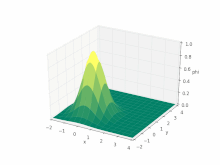Advection
This article needs additional citations for verification. (May 2022) |
In the field of
that can hold or contain the quantity or substance.During advection, a fluid transports some conserved quantity or material via bulk motion. The fluid's motion is described mathematically as a vector field, and the transported material is described by a scalar field showing its distribution over space. Advection requires currents in the fluid, and so cannot happen in rigid solids. It does not include transport of substances by molecular diffusion.
Advection is sometimes confused with the more encompassing process of convection, which is the combination of advective transport and diffusive transport.
In meteorology and physical oceanography, advection often refers to the transport of some property of the atmosphere or ocean, such as heat, humidity (see moisture) or salinity. Advection is important for the formation of
Distinction between advection and convection

The term advection often serves as a synonym for convection, and this correspondence of terms is used in the literature. More technically, convection applies to the movement of a fluid (often due to density gradients created by thermal gradients), whereas advection is the movement of some material by the velocity of the fluid. Thus, although it might seem confusing, it is technically correct to think of momentum being advected by the velocity field in the Navier-Stokes equations, although the resulting motion would be considered to be convection. Because of the specific use of the term convection to indicate transport in association with thermal gradients, it is probably safer to use the term advection if one is uncertain about which terminology best describes their particular system.
Meteorology
In
Other quantities
The advection equation also applies if the quantity being advected is represented by a probability density function at each point, although accounting for diffusion is more difficult.[1]
Mathematics of advection
The advection equation is the
One easily visualized example of advection is the transport of ink dumped into a river. As the river flows, ink will move downstream in a "pulse" via advection, as the water's movement itself transports the ink. If added to a lake without significant bulk water flow, the ink would simply disperse outwards from its source in a diffusive manner, which is not advection. Note that as it moves downstream, the "pulse" of ink will also spread via diffusion. The sum of these processes is called convection.
The advection equation
In Cartesian coordinates the advection operator is
The advection equation for a conserved quantity described by a scalar field is expressed mathematically by a continuity equation:
where is the divergence operator and again is the
In this case, is said to be
In particular, if the flow is steady, then
If a vector quantity (such as a
Here, is a vector field instead of the scalar field .
Solving the equation

The advection equation is not simple to solve numerically: the system is a hyperbolic partial differential equation, and interest typically centers on discontinuous "shock" solutions (which are notoriously difficult for numerical schemes to handle).
Even with one space dimension and a constant
According to Zang,[2] numerical simulation can be aided by considering the skew-symmetric form for the advection operator.
where
Since skew symmetry implies only
Using vector calculus identities, these operators can also be expressed in other ways, available in more software packages for more coordinate systems.
This form also makes visible that the skew-symmetric operator introduces error when the velocity field diverges. Solving the advection equation by numerical methods is very challenging and there is a large scientific literature about this.
See also
- Advection-diffusion equation
- Atmosphere of Earth
- Conservation equation
- Courant–Friedrichs–Lewy condition
- Kinematic wave
- Overshoot (signal)
- Péclet number
- Radiation
References
- ISBN 978-1-138-00086-5.
- .
- ^ Boyd, John P. (2000). Chebyshev and Fourier Spectral Methods 2nd edition. Dover. p. 213.



















![{\displaystyle \nabla \cdot ({\mathbf {u} }{\mathbf {u} })=[\nabla \cdot ({\mathbf {u} }u_{x}),\nabla \cdot ({\mathbf {u} }u_{y}),\nabla \cdot ({\mathbf {u} }u_{z})]}](https://wikimedia.org/api/rest_v1/media/math/render/svg/aca3db043ee3609860cdbbba5c1f13f9de495f29)

